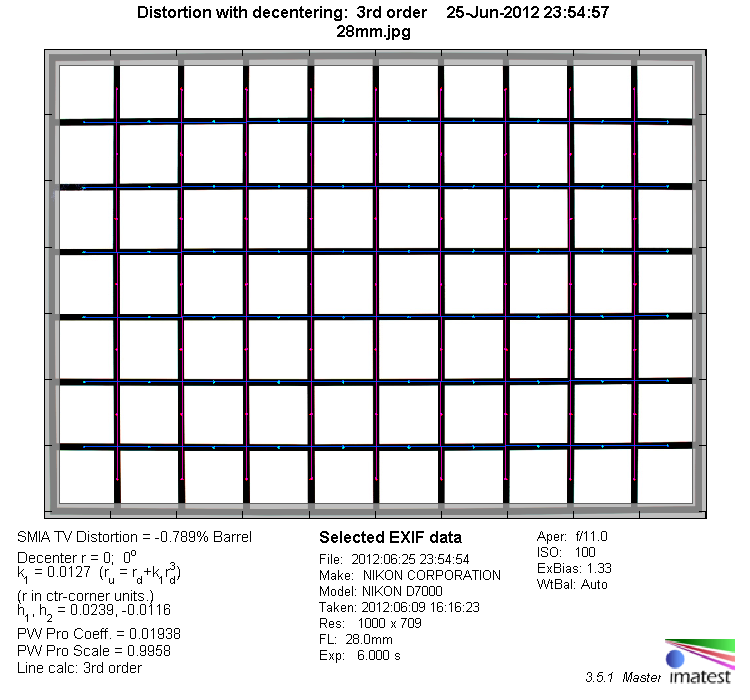|
Page 2 of 2

Distortion
On DX cameras the lens shows a small amount of barrel distortion. For most subjects this should not be an issue.

The chart above has a real-world size of about 120x80cm.
Vignetting
Being a FX lens, the Nikkor profits from the sweet spot advantage on DX cameras and consequently shows only moderate vignetting wide open, which is reduced to an irrelevant level at f/2.8 and beyond.

MTF (resolution)
The lens delivers very good resolution in the image center wide open already. Stopping down lifts the center resolution to excellent levels until diffraction takes its toll at f/11 and beyond.
The borders and corners follow a good deal behind, with only fair resolution at large apertures. Stopped down to medium apertures, the resolution increases significantly to very good figures.
It's interesting to see a quite pronounced drop off in quality towards the borders compared to the FX results of the lens. This is most likely the result of two effects: first of all the high density DX sensor is more demanding, especially towards the image borders. In addition Nikon's published MTF chart for the lens shows a "dent" in the MTF curve that is within the DX frame. This dent may well be emphasized with higher pixel densities/higher frequencies.
Please note that the MTF results are not directly comparable across the different systems!
Below is a simplified summary of the formal findings. The chart shows line widths per picture height (LW/PH) which can be taken as a measure for sharpness.
If you want to know more about the MTF50 figures you may check out the corresponding Imatest Explanations

Chromatic Aberrations (CAs)
Chromatic aberrations (color shadows at harsh contrast transitions) range from roughly 1 to 1.2 pixels at the image borders throughout the tested aperture range. This might be visible in very large prints (or crops). However, CAs can easily be corrected in software or by the camera itself (most modern Nikon DSLRs remove CAs themselves if you shoot JPGs).

Bokeh
One of the primary usage scenarios for a large aperture lens is to separate the main subject from the background. In such an image the quality of the bokeh (out-of-focus blur) is of major significance.
Except for the transition zone, where image blur can be somewhat nervous, the lens delivers quite smooth bokeh, especially for a wide-angle lens.
Background highlights retain their circular shape at least as long as the lens is stopped down only moderately. They do show only a small amount of outlining, but suffer a little from bokeh fringing (see next section).

Bokeh Fringing
Bokeh fringing (non-coinciding focal planes of the various colors) is a common issue with relatively fast glass. As you can notice below, the halos have different colors - magenta (red + blue) in front the focus point and green beyond. Truly "apochromatic" lenses don't show this kind of fringing but these lenses are very rare especially below 100mm. Unlike lateral lateral CAs, bokeh fringing cannot easily be fixed in post processing.
Typical for most fast primes, the AF-S 28/1.8 shows some amount of fringing at large aperture settings, which can of course be reduced by stopping down.
These shots also illustrate that the lens does not suffer from focus shift when stopping down (focus shifts are not uncommon for fast prime lenses). This is true not only for very short focus distances (as in the shots below) but also for larger subject distances.
Sample Images
You can find some sample images taken with the Nikon D3x in our Nikon FX review of the lens.
VerdictThe Nikon AF-S 28mm f/1.8 G convinces with very solid performance on our DX test camera. Sharpness is very good in the image center wide open already and improves to excellent resolution by stopping down. The borders and corners are weak at large apertures, but improve significantly by stopping down.
Distortion and CAs are moderate, the bokeh is quite smooth for a lens of this focal length. Typical for FX lenses on DX cameras, vignetting is not an issue except for the largest aperture setting.
The build quality is on a high level for a consumer grade lens. Thanks to AF-S the autofocus is virtually silent and reasonably fast.
So, in summary it's a nice lens that performs well as a normal prime on DX cameras. However, there are dedicated DX lenses like the Nikkor AF-S 35/1.8 or Sigma's EX 30/1.4 DC that offer similar specifications for a lot less money.
One final note: there have been reports of pronounced focus shifts with this lens. We had no such issues with our review unit. The focus remained unchanged regardless of the aperture chosen (in the tested range down to f/11), both in the lab and in the field.
|